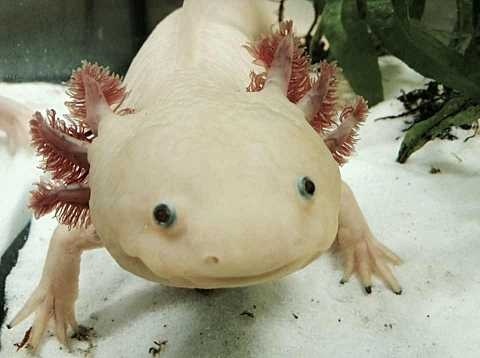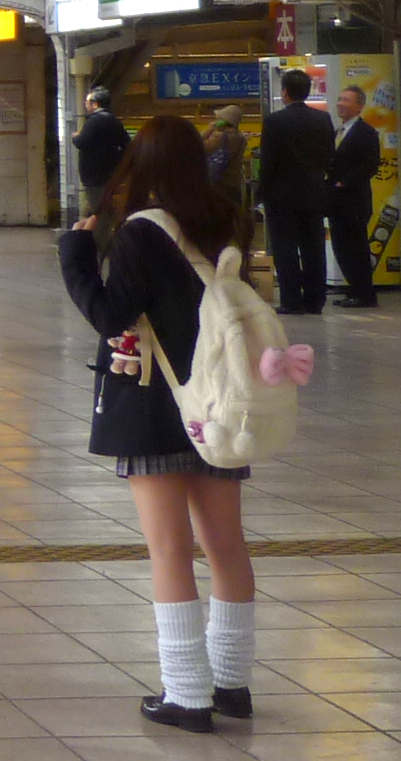|
Erina Matsui
is a contemporary Japanese artist. She is known for her surreal self-portraits, mostly done as oil paintings. Her work has been praised for its jarring visual impact as it defies normal representations of childhood being cute and innocent. Early life and education Matsui was born in 1984 in Okayama, Japan where she grew up. As a student, she studied oil painting and went on to win the Shell Art Award in 2004. Her education also led her to study abroad in Finland as an exchange student at the University of Art & Design Helsinki in 2006. She graduated in 2008 with a B.F.A. from Tama Art University in Tokyo, and completed her M.A. in 2010 at the Tokyo University of the Arts. She continued her education in 2012 by fulfilling an artist residency at the Kunstlerhaus Bethanien in Germany, having been sponsored as a fellow for Japan's Agency of Cultural Affairs Overseas Training Program. Career Before she even graduated from Tama Art University, Matsui debuted as a rising artist in ... [...More Info...] [...Related Items...] OR: [Wikipedia] [Google] [Baidu] |
Okayama, Japan
is a Prefectures of Japan, prefecture of Japan located in the Chūgoku region of Honshu. Okayama Prefecture has a population of 1,906,464 (1 February 2018) and has a geographic area of 7,114 Square kilometre, km2 (2,746 sq mi). Okayama Prefecture borders Tottori Prefecture to the north, Hyōgo Prefecture to the east, and Hiroshima Prefecture to the west. Okayama is the capital and largest city of Okayama Prefecture, with other major cities including Kurashiki, Tsuyama, and Sōja. Okayama Prefecture's south is located on the Seto Inland Sea coast across from Kagawa Prefecture on the island of Shikoku, which are connected by the Great Seto Bridge, while the north is characterized by the Chūgoku Mountains. History Prior to the Meiji Restoration of 1868, the area of present-day Okayama Prefecture was divided between Bitchū Province, Bitchū, Bizen Province, Bizen and Mimasaka Province, Mimasaka Provinces. Okayama Prefecture was formed and named in 1871 as part of the large-scal ... [...More Info...] [...Related Items...] OR: [Wikipedia] [Google] [Baidu] |
Kirishima Open Air Museum
opened in Yūsui, Kagoshima Prefecture, Japan, in 2000. Located in the foothills of Mount Kirishima, at an elevation of seven hundred metres above sea level, the Museum encompasses an area of 20 hectares. Works are displayed in the open air as well as in the Art Hall. See also * Kirishima-Yaku National Park is a national park in Kyūshū, Japan. It is composed of Kirishima-Kagoshima Bay, an area of Kagoshima Prefecture and Miyazaki Prefecture known for its active volcanoes, volcanic lakes, and onsen. The total area is . History On March 16, 1934 ... References External links *Kirishima Open Air Museum*Collection*Kirishima Open Air Museum Museums in Kagoshima Prefecture Yūsui, Kagoshima Art museums and galleries in Japan Open-air museums in Japan Art museums established in 2000 2000 establishments in Japan {{Japan-museum-stub ... [...More Info...] [...Related Items...] OR: [Wikipedia] [Google] [Baidu] |
Tokyo University Of The Arts Alumni
Tokyo (; ja, 東京, , ), officially the Tokyo Metropolis ( ja, 東京都, label=none, ), is the capital and largest city of Japan. Formerly known as Edo, its metropolitan area () is the most populous in the world, with an estimated 37.468 million residents ; the city proper has a population of 13.99 million people. Located at the head of Tokyo Bay, the prefecture forms part of the Kantō region on the central coast of Honshu, Japan's largest island. Tokyo serves as Japan's economic center and is the seat of both the Japanese government and the Emperor of Japan. Originally a fishing village named Edo, the city became politically prominent in 1603, when it became the seat of the Tokugawa shogunate. By the mid-18th century, Edo was one of the most populous cities in the world with a population of over one million people. Following the Meiji Restoration of 1868, the imperial capital in Kyoto was moved to Edo, which was renamed "Tokyo" (). Tokyo was devasta ... [...More Info...] [...Related Items...] OR: [Wikipedia] [Google] [Baidu] |
Tama Art University Alumni
Tama may mean: Languages * Tama language, the language of the Sudanese Tama people * Tama languages, a language family of northern Papua New Guinea Music * Tama Drums, a Japanese brand manufactured by Hoshino Gakki * Tama (percussion), a type of talking drum from West Africa * "Tama", a song by Mory Kanté People * Tama Hochbaum (born 1953), American artist and photographer * Tama people, an ethnic group in Chad and Sudan * La Tama, previously Ocute, a Native American people of the U.S. state of Georgia * Tama, the ring name of professional wrestler Sam Fatu * Tama, clan of junior Kazakh Jüz "horde", numbering ca. 70–115,000 * Tama people (Colombia), an indigenous group of Colombia Places * Tama, Iowa, United States * Tama County, Iowa, United States * Tama, Niger * Tama, La Rioja, Argentina * Tama, Musashi (), an old district in Musashi Province, Japan ** Tama Area (), the western portion of Tokyo Prefecture *** Tama Cemetery, the largest municipal cemetery in Japan *** ... [...More Info...] [...Related Items...] OR: [Wikipedia] [Google] [Baidu] |
1984 Births
Events January * January 1 – The Bornean Sultanate of Brunei gains full independence from the United Kingdom, having become a British protectorate in 1888. * January 7 – Brunei becomes the sixth member of the Association of Southeast Asian Nations (ASEAN). * January 10 ** The United States and the Vatican (Holy See) restore full diplomatic relations. ** The Victoria Agreement is signed, institutionalising the Indian Ocean Commission. *January 24 – Steve Jobs launches the Macintosh personal computer in the United States. February * February 3 ** Dr. John Buster and the research team at Harbor–UCLA Medical Center announce history's first embryo transfer from one woman to another, resulting in a live birth. ** STS-41-B: Space Shuttle ''Challenger'' is launched on the 10th Space Shuttle mission. * February 7 – Astronauts Bruce McCandless II and Robert L. Stewart make the first untethered space walk. * February 8– 19 – The 1984 Winter Olympics are held in Sarajev ... [...More Info...] [...Related Items...] OR: [Wikipedia] [Google] [Baidu] |
Living People
Related categories * :Year of birth missing (living people) / :Year of birth unknown * :Date of birth missing (living people) / :Date of birth unknown * :Place of birth missing (living people) / :Place of birth unknown * :Year of death missing / :Year of death unknown * :Date of death missing / :Date of death unknown * :Place of death missing / :Place of death unknown * :Missing middle or first names See also * :Dead people * :Template:L, which generates this category or death years, and birth year and sort keys. : {{DEFAULTSORT:Living people 21st-century people People by status ... [...More Info...] [...Related Items...] OR: [Wikipedia] [Google] [Baidu] |
Fundació Joan Miró
The Fundació Joan Miró ( ; "Joan Miró Foundation, Centre of Studies of Contemporary Art") is a museum of modern art honoring Joan Miró located on the hill called Montjuïc in Barcelona, Catalonia (Spain). History The idea for the foundation was made in 1968 by Joan Miró. Miró formed the foundation with his friend Joan Prats. Miró wanted to create a new building that would encourage particularly younger artists to experiment with contemporary art. The building was designed by Josep Lluís Sert to ensure that this work could also be made available to the public and exhibited. He designed the building with courtyards and terraces and to create a natural path for visitors to move through the building. Building began on the mountain of Montjuïc and the foundation opened on 10 June 1975. Not only was the architect a close friend of Miró but so was the first president Joaquim Gomis and Miró was amongst the first board. It was claimed that the new foundation represented a ne ... [...More Info...] [...Related Items...] OR: [Wikipedia] [Google] [Baidu] |
Axolotl
The axolotl (; from nci, āxōlōtl ), ''Ambystoma mexicanum'', is a paedomorphic salamander closely related to the tiger salamander. Axolotls are unusual among amphibians in that they reach adulthood without undergoing metamorphosis. Instead of taking to the land, adults remain aquatic and gilled. The species was originally found in several lakes underlying what is now Mexico City, such as Lake Xochimilco and Lake Chalco. These lakes were drained by Spanish settlers after the conquest of the Aztec Empire, leading to the destruction of much of the axolotl’s natural habitat. Axolotls should not be confused with the larval stage of the closely related tiger salamander (''A. tigrinum''), which are widespread in much of North America and occasionally become paedomorphic. Neither should they be confused with mudpuppies (''Necturus'' spp.), fully aquatic salamanders from a different family that are not closely related to the axolotl but bear a superficial resemblance. , ... [...More Info...] [...Related Items...] OR: [Wikipedia] [Google] [Baidu] |
Kawaii
''Kawaii'' is the culture of cuteness in Japan. It can refer to items, humans and non-humans that are charming, vulnerable, shy and childlike.Kerr, Hui-Ying (23 November 2016)"What is kawaii – and why did the world fall for the ‘cult of cute’?", ''The Conversation''. Examples include cute handwriting, certain genres of manga, anime, and characters including Hello Kitty and Pikachu. The cuteness culture, or ''kawaii'' aesthetic, has become a prominent aspect of Japanese popular culture, entertainment, clothing, food, toys, personal appearance, and mannerisms. Etymology The word ''kawaii'' originally derives from the phrase ''kao hayushi'', which literally means "(one's) face (is) aglow," commonly used to refer to flushing or blushing of the face. The second morpheme is cognate with ''-bayu'' in '' mabayui'' (眩い, 目映い, or 目映ゆい) "dazzling, glaring, blinding, too bright; dazzlingly beautiful" (''ma-'' is from ''me'' "eye") and ''-hayu'' in ''omohayui'' ... [...More Info...] [...Related Items...] OR: [Wikipedia] [Google] [Baidu] |
Kaikai Kiki
is a Japanese contemporary artist. He works in fine arts media (such as painting and sculpture) as well as commercial (such as fashion, merchandise, and animation) and is known for blurring the line between high and low arts as well as co aesthetic characteristics of the Japanese artistic tradition and the nature of postwar Japanese culture and society, and is also used for Murakami's artistic style and other Japanese artists he has influenced. Murakami is the founder and President of Kaikai Kiki Co., Ltd., through which he manages several younger artists. He was the founder and organizer of the biannual art fair Geisai. Life and career Academic background and early career Murakami was born and raised in Tokyo, Japan. From early on, he was a fan of anime and manga (Japanese cartoons and comics respectively), and hoped to work in the animation industry. He attended Tokyo University of the Arts to acquire the drafting skills necessary to become an animator, but eventual ... [...More Info...] [...Related Items...] OR: [Wikipedia] [Google] [Baidu] |
Superflat
Superflat is a postmodern art movement, founded by the artist Takashi Murakami, which is influenced by manga and anime. However, superflat doesn't have an explicit definition because Takashi Murakami does not want to limit the movement, but rather leave room for it to grow and evolve over time. Superflat is also the name of a 2000 art exhibition, curated by Murakami, that toured West Hollywood, Minneapolis and Seattle. Description "Superflat" is used by Murakami to refer to various flattened forms in Japanese graphic art, animation, pop culture and fine arts, as well as the "shallow emptiness of Japanese consumer culture." Superflat has been embraced by American artists, who have created a hybrid called " SoFlo Superflat". Murakami defines ''Superflat'' in broad terms, so the subject matter is very diverse. Some works explore the consumerism and sexual fetishism that is prevalent in post-war Japanese culture. This often includes lolicon art, which is parodied by works such as tho ... [...More Info...] [...Related Items...] OR: [Wikipedia] [Google] [Baidu] |



